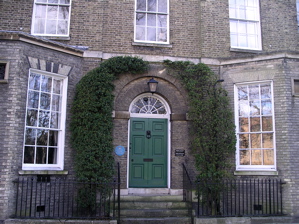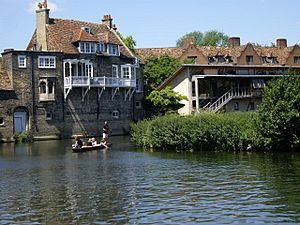Gwen Raverat facts for kids
Quick facts for kids
Gwen Raverat
|
|
|---|---|
| Born |
Gwendolen Mary Darwin
26 August 1885 Cambridge, England
|
| Died | 11 February 1957 (aged 71) Cambridge, England
|
| Resting place | Trumpington Extension Cemetery, Cambridge |
| Alma mater | Slade School of Fine Art |
| Occupation | Wood Engraver |
| Years active | 1911–1951 |
|
Notable work
|
Period Piece (autobiography) |
| Spouse(s) |
Jacques Raverat
(m. 1911–1925) |
| Children | Elisabeth (1916–2014) Sophie Jane (1919–2011) |
| Parent(s) | George Darwin Maud du Puy |
| Relatives | Sophie Gurney (daughter) Darwin–Wedgwood family |
Gwen Raverat (born Gwendolen Mary Darwin; August 26, 1885 – February 11, 1957) was an English artist. She was famous for her beautiful wood engravings. She also helped start the Society of Wood Engravers. Gwen wrote a popular book about her childhood called Period Piece, which came out in 1952.
Contents
About Gwen Raverat's Life
Gwen Raverat was born in Cambridge, England, in 1885. Her father was Sir George Darwin, a famous astronomer. Her mother was Lady Darwin, whose maiden name was Maud du Puy. Gwen's grandfather was the very well-known naturalist, Charles Darwin. This means she was part of the famous Darwin–Wedgwood family.
In 1911, Gwen married a French painter named Jacques Raverat. They were part of a group of artists and writers called the Bloomsbury Group. Later, they moved to the south of France, living near Nice. Jacques sadly passed away in 1925 from a sickness called multiple sclerosis.
Gwen and Jacques had two daughters. Their names were Elisabeth (born 1916) and Sophie Jane (born 1919).
Gwen Raverat is buried in the Trumpington Extension Cemetery in Cambridge, next to her father. There is also a special memorial for her in Harlton Church, Cambridgeshire.
Cambridge was always very important to Gwen. Her childhood home, Newnham Grange, is now part of Darwin College, Cambridge. She also lived in a nearby house called the Old Granary from 1946 until she died. Darwin College has even named one of its student buildings after her.
Gwen Raverat's Wood Engravings
Gwen Raverat was one of the first artists to be known for modern wood engraving. She studied at the Slade School of Fine Art in 1908. She developed her own unique style of engraving, which was influenced by Impressionism and Post-impressionism. Her work often looked like paintings.
One of her first wood engravings appeared in a book in 1911. It was called "Lord Thomas and Fair Annet."
Gwen Raverat is known for illustrating one of the first books with modern wood engravings. This was Spring Morning (1915), written by her cousin Frances Cornford.
Many of Gwen's engravings were for her friends in Cambridge. She also reached a wider audience through the London Mercury magazine. Some of her most famous engravings are "Six Rivers Round London," which she made for a bus company.
Most of Gwen's work illustrating books happened in the 1930s. She created engravings for Kenneth Grahame's The Cambridge Book of Poetry for Children (1932). The Cambridge University Press printed her work with great care, using her original wood blocks. She illustrated several other books for them, including Four Tales from Hans Andersen (1935) and The Bird Talisman (1939). Some of these had color wood engravings.
Gwen also spent a year making 29 wood engravings for a special edition of Les Amours de Daphne et Chloe (1933).
In 1934, she made engravings for Farmer's Glory by A. G. Street, which is one of her most recognized works. She also illustrated A Sentimental Journey (1938) for Penguin Illustrated Classics. Her last wood engravings were for a book called London Bookbinders 1780–1806 (1950).
Besides wood engravings, Gwen also illustrated books with line drawings. These included Over The Garden Wall (1933) and Mustard, Pepper and Salt (1938).
Gwen Raverat played a very important part in bringing back wood engraving in Britain. By 1914, she had made about sixty wood engravings, more than many other artists at the time. She showed her work at almost every yearly exhibition of the Society of Wood Engravers from 1920 to 1940. She displayed 122 engravings, more than anyone else.
Sadly, Gwen had to stop wood engraving after she had a stroke in 1951.
Her artwork was even part of the art competition at the 1948 Summer Olympics. Her work has also been shown in major exhibitions, like "Print and Prejudice: Women Printmakers, 1700-1930" at the Victoria and Albert Museum in London.
Gwen Raverat's Connection to Cambridge
Except for her time studying and living with her husband, Gwen Raverat spent most of her life in or near Cambridge. In 1928, she moved to the Old Rectory in Harlton, near Cambridge. This house was the inspiration for her engravings in the book The Runaway. In 1946, she moved to The Old Granary in Silver Street, which was right next to her childhood home.
Her life in Cambridge involved many friends and activities. She often designed costumes, scenery, and programs for theatre shows. In 1908, she designed costumes for a play called Comus by John Milton. She also helped create the scenery and costumes for a ballet called Job, a masque for dancing (1931). Her second cousin, Ralph Vaughan Williams, wrote the music for this ballet. A small model of the stage set she built is now kept at the Fitzwilliam Museum in Cambridge. She designed for about ten more productions, mostly for the Cambridge University Musical Society.
Gwen also loved children's stories. She convinced publishers to reprint three Victorian children's books: The Runaway, The Bird Talisman, and Countess Kate.
Period Piece: A Childhood Memoir
When Gwen Raverat was 62 years old, she began writing her famous book about her childhood. It was called Period Piece. She also drew many charming line drawings to illustrate the book. It was published in 1952 and has been a popular book ever since.
Memberships and Groups
Gwen Raverat was a very important founding member of the Society of Wood Engravers. This group held yearly exhibitions that showed works from many other talented artists.
See also
 In Spanish: Gwen Raverat para niños
In Spanish: Gwen Raverat para niños
- List of Bloomsbury Group people



